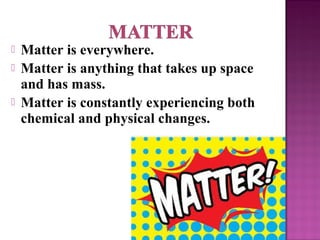Grade 10 chemical change
- 1. NEENA HARIDAS Physical Science Reg. No: 13971014
- 2. ÔÇû To study the difference between a physical and chemical change.
- 3. ÔÇû Matter is everywhere. ÔÇû Matter is anything that takes up space and has mass. ÔÇû Matter is constantly experiencing both chemical and physical changes.
- 4. ÔÇû A physical change alters the form of a substance, but does not change it to another substance. ÔÇû It changes shape or size ÔÇû It dissolves. ÔÇû It changes phase (freezes, boils, evaporates, condenses) ÔÇû Example: Making Orange Juice
- 5. ÔÇû Physical changes occur when matter changes its property but not its chemical nature. ÔÇû Physical property changes could include a change in: texture, shape, size, color, odor, volume, mass, weight, and density.
- 6. ÔÇû Crushing an aspirin ÔÇû A Boiled egg Physical Change
- 7. ÔÇû Cutting paper? Physical Change
- 8. ÔÇû Physical Change Ice melting?
- 11. Dry ice? ÔÇû Physical Change
- 12. ÔÇû Chemical changes are changes matter undergoes when it becomes new or different matter. ÔÇû It burns ÔÇû Temperature changes without heating/cooling ÔÇû It bubbles (makes a gas) ÔÇû It changes color ÔÇû It forms a precipitate
- 13. ÔÇû When a substance undergoes a chemical change, it is changed into a different substance with different properties. ÔÇû To identify a chemical change look for signs such as color change, bubbling and fizzing, light production, smoke, and presence of heat. ÔÇû Example: Baking a Cake
- 14. 1. Precipitation 2. Color Change
- 15. 4. Temperature Change 3. Gas Production
- 16. ÔÇû A chemical change occurs when fireworks are used. Fireworks are made of metals such as magnesium and copper. These change chemically as they light up the sky.
- 17. ÔÇû Lighter fluid burining Chemical Change
- 18. ÔÇû Sugar dissolving in tea Examples for Chemical Change ÔÇû Logs burning ÔÇû Breaking water up by separating it into hydrogen and oxygen
- 20.  Rocket fuel burning? Chemical Change
- 21. ÔÇû Metal rusting? Chemical Change
- 23. ÔÇû Tears up paper? Physical change ÔÇû Mixes salt and water? Physical change ÔÇû Burns paper? Chemical change ÔÇû Evaporates salt water? Physical change ÔÇû Mixes vinegar and baking soda? Chemical change
- 24. ÔÇû Write a paragraph about the difference between a chemical and physical change. Give examples of each.
























